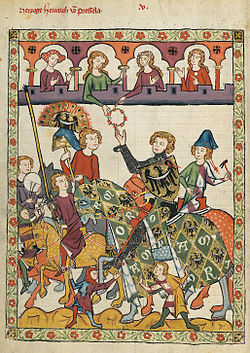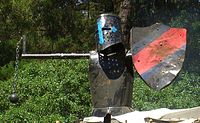115:
331:(or peacock), may have included a number of lance games, often used as training for jousting, where the competitor would attempt to strike an object with a lance. The common object was a shield or board on a pole (usually referred to, confusingly, as 'the quintain'), although a mannequin was sometimes used. While the use of horses aided in training for the joust, the game could be played on foot, using a wooden horse, or on boats (popular in 12th-century London).
1009:
999:
302:
25:
1019:
343:
is a duel between two knights, but rather than conducting three passes, each of the three duels are fought until one knight has received three solid blows from their opponent. While frequently referred to by contemporary sources, and included (separately) in various prohibitions and declarations over
160:, but over the medieval period a number of other games and sports developed, which differed in popularity and rules from area to area, and from period to period. Distinction was made between the different types by contemporaries in their description, laws, prohibitions, and customs.
141:, literally "lance game". By the 14th century, the term usually excluded tournaments and was used to describe the other games collectively; this seems to have coincided with the increasing preference for ritualistic and individualistic games over the traditional
219:
Jousts originally developed out of the charge at the beginning of the mêlée, but by the 13th century it had become quite distinct from the tourney. That it was seen as a separate event, with its own rules and customs, is clear from historical documents such as
287:(the latter term being modern) refer to a class of hastiludes that involve groups of fighters simulating cavalry combat. This type of game formed the core of the tournament during the high medieval period.
200:
More informal jousting events would have several horsemen within the lists at once, where each waited to take up the challenge of another, although the aim remained for the joust to be a one-on-one duel.
263:
or "comers") must first fight, or be disgraced. If a traveling venant did not have weapons or horse to meet the challenge, one might be provided, and if the venant chose not to fight, he would leave his
228:
the joust. By the nature of its duel, and the discrete space required for the action, the joust became a popular spectator and ceremonial sport, with elaborate rituals developing around the whole event.
268:
behind as a sign of humiliation. If a lady passed unescorted, she would leave behind a glove or scarf, to be rescued and returned to her by a future knight who passed that way.
462:
212:, where knights sought to unhorse their opponents. These types called for different lances (light in the former, heavy in the latter), and saddles (where the
828:
964:
204:
There were several types of joust, including some regional preferences or rules. For example, in 14th century
Germany, distinction was made between the
185:
In contrast to the tournament, which comprised teams of large numbers ranging over large tracts of land, the joust was fought between two individuals on
348:. It is clearly a hastilude, or wargame, of some kind, and distinct from the other types, but there seems to be no clear description of its rules.
259:
or "holders") who would stake out a traveled spot, such as a bridge or city gate, and let it be known that any other knight who wished to pass (
477:
554:
253:
hastilude that evolved in the late 14th century and remained popular through the 15th century. It involved a knight or group of knights (
1048:
35:
432:
888:
863:
803:
93:
979:
65:
1022:
984:
514:
405:
482:
72:
848:
788:
760:
519:
50:
327:, a street between the fifth and sixth maniples of a camp, where warlike exercises took place), also known as
934:
765:
79:
944:
939:
929:
893:
735:
637:
197:. In the early 15th century, a barrier was introduced to keep the horses apart, to avoid collisions.
61:
1043:
662:
425:
186:
913:
617:
587:
974:
730:
504:
793:
685:
642:
169:
149:
1012:
954:
750:
657:
627:
612:
418:
221:
8:
898:
878:
858:
823:
755:
667:
534:
296:
1002:
838:
813:
715:
592:
544:
539:
529:
467:
86:
1053:
998:
740:
710:
700:
690:
607:
597:
582:
449:
401:
114:
959:
908:
903:
843:
808:
720:
677:
647:
569:
487:
457:
309:
46:
969:
883:
853:
577:
494:
216:
called for saddles without front or rear supports, which would impede the fall).
873:
818:
772:
725:
705:
549:
472:
240:
193:. The two would ride at each other from opposite ends, charging with a couched
1037:
632:
393:
119:
798:
695:
499:
134:
949:
652:
559:
441:
306:
130:
524:
410:
142:
602:
24:
868:
745:
622:
301:
250:
180:
157:
509:
254:
344:
the medieval period, little is known about the nature of the
321:
194:
42:
265:
118:
A knight receiving a lady's favour at a hastilude. From
148:
Today, the most well-known of the hastiludes are the
1035:
208:, where the aim was to break the lance, and the
189:, in a small, defined ground often known as the
426:
51:introducing citations to additional sources
433:
419:
440:
300:
113:
41:Relevant discussion may be found on the
16:Generic Medieval name for martial games.
1036:
224:'s 1309 ban of all forms of hastilude
163:
414:
398:The Tournament in England: 1100–1400
271:
18:
1018:
463:Decline of the Western Roman Empire
13:
555:Growth of the Eastern Roman Empire
14:
1065:
985:Historiography in the Middle Ages
249:or passage of arms was a type of
137:. The word comes from the Latin
1049:Historical European martial arts
1017:
1008:
1007:
997:
34:relies largely or entirely on a
23:
483:Christianity in the Middle Ages
478:Decline of Hellenistic religion
761:Crisis of the late Middle Ages
375:
366:
357:
232:
129:is a generic term used in the
1:
935:Disability in the Middle Ages
608:Rise of the Republic of Genoa
540:Rise of the Venetian Republic
387:
334:
7:
290:
10:
1070:
736:Rise of the Ottoman Empire
381:Barker (1986), pp. 149–51.
294:
238:
178:
167:
133:to refer to many kinds of
993:
922:
781:
676:
663:Mongol invasion of Europe
568:
448:
363:Barker (1986), pp. 138–9.
351:
174:
618:Investiture Controversy
588:Second Bulgarian Empire
255:
975:Post-classical history
731:Fall of Constantinople
638:Capet–Plantagenet feud
505:First Bulgarian Empire
372:Barker (1986), p. 147.
313:
123:
304:
170:Tournament (medieval)
168:Further information:
117:
955:Medieval reenactment
751:Renaissance Humanism
658:Medieval Warm Period
628:Republic of Florence
442:European Middle Ages
400:, UK: Boydell Press
310:Renaissance Festival
222:Edward II of England
47:improve this article
668:Kingdom of Portugal
535:Old Church Slavonic
520:Anglo-Saxon England
297:Quintain (jousting)
164:Types of hastiludes
849:In popular culture
814:Crusading movement
686:Hundred Years' War
545:Civitas Schinesghe
530:Carolingian Empire
515:Kingdom of Croatia
468:Barbarian kingdoms
314:
124:
1031:
1030:
940:Basic topics list
741:Swiss mercenaries
691:Wars of the Roses
598:Kingdom of Poland
583:Holy Roman Empire
450:Early Middle Ages
272:Mêlée and behourd
112:
111:
97:
1061:
1044:Medieval culture
1021:
1020:
1011:
1010:
1001:
960:Medieval studies
804:Church and State
678:Late Middle Ages
570:High Middle Ages
488:Christianization
458:Migration Period
435:
428:
421:
412:
411:
382:
379:
373:
370:
364:
361:
305:Quintain at the
258:
206:Hohenzeuggestech
107:
104:
98:
96:
55:
27:
19:
1069:
1068:
1064:
1063:
1062:
1060:
1059:
1058:
1034:
1033:
1032:
1027:
989:
970:Neo-medievalism
918:
854:Itinerant court
777:
672:
593:Georgian Empire
578:Norman Conquest
564:
510:Frankish Empire
444:
439:
390:
385:
380:
376:
371:
367:
362:
358:
354:
337:
299:
293:
274:
243:
237:
183:
177:
172:
166:
108:
102:
99:
56:
54:
40:
28:
17:
12:
11:
5:
1067:
1057:
1056:
1051:
1046:
1029:
1028:
1026:
1025:
1015:
1005:
994:
991:
990:
988:
987:
982:
977:
972:
967:
965:Misconceptions
962:
957:
952:
947:
942:
937:
932:
926:
924:
920:
919:
917:
916:
911:
906:
901:
896:
891:
886:
881:
876:
871:
866:
861:
856:
851:
846:
841:
836:
831:
826:
821:
816:
811:
806:
801:
796:
791:
785:
783:
779:
778:
776:
775:
773:Little Ice Age
770:
769:
768:
758:
753:
748:
743:
738:
733:
728:
726:Western Schism
723:
718:
713:
708:
703:
698:
693:
688:
682:
680:
674:
673:
671:
670:
665:
660:
655:
650:
645:
640:
635:
630:
625:
620:
615:
610:
605:
600:
595:
590:
585:
580:
574:
572:
566:
565:
563:
562:
557:
552:
547:
542:
537:
532:
527:
522:
517:
512:
507:
502:
497:
492:
491:
490:
480:
475:
473:Late antiquity
470:
465:
460:
454:
452:
446:
445:
438:
437:
430:
423:
415:
409:
408:
394:Barker, Juliet
389:
386:
384:
383:
374:
365:
355:
353:
350:
336:
333:
295:Main article:
292:
289:
273:
270:
239:Main article:
236:
231:
179:Main article:
176:
173:
165:
162:
110:
109:
45:. Please help
31:
29:
22:
15:
9:
6:
4:
3:
2:
1066:
1055:
1052:
1050:
1047:
1045:
1042:
1041:
1039:
1024:
1016:
1014:
1006:
1004:
1000:
996:
995:
992:
986:
983:
981:
978:
976:
973:
971:
968:
966:
963:
961:
958:
956:
953:
951:
948:
946:
943:
941:
938:
936:
933:
931:
928:
927:
925:
921:
915:
912:
910:
907:
905:
902:
900:
897:
895:
892:
890:
887:
885:
882:
880:
877:
875:
872:
870:
867:
865:
862:
860:
857:
855:
852:
850:
847:
845:
842:
840:
837:
835:
832:
830:
827:
825:
822:
820:
817:
815:
812:
810:
807:
805:
802:
800:
797:
795:
792:
790:
787:
786:
784:
780:
774:
771:
767:
764:
763:
762:
759:
757:
754:
752:
749:
747:
744:
742:
739:
737:
734:
732:
729:
727:
724:
722:
719:
717:
714:
712:
709:
707:
704:
702:
699:
697:
694:
692:
689:
687:
684:
683:
681:
679:
675:
669:
666:
664:
661:
659:
656:
654:
651:
649:
646:
644:
641:
639:
636:
634:
633:Scholasticism
631:
629:
626:
624:
621:
619:
616:
614:
611:
609:
606:
604:
601:
599:
596:
594:
591:
589:
586:
584:
581:
579:
576:
575:
573:
571:
567:
561:
558:
556:
553:
551:
548:
546:
543:
541:
538:
536:
533:
531:
528:
526:
523:
521:
518:
516:
513:
511:
508:
506:
503:
501:
498:
496:
495:Rise of Islam
493:
489:
486:
485:
484:
481:
479:
476:
474:
471:
469:
466:
464:
461:
459:
456:
455:
453:
451:
447:
443:
436:
431:
429:
424:
422:
417:
416:
413:
407:
406:0-85115-450-6
403:
399:
395:
392:
391:
378:
369:
360:
356:
349:
347:
342:
332:
330:
326:
323:
319:
311:
308:
303:
298:
288:
286:
282:
278:
269:
267:
262:
257:
252:
248:
242:
235:
230:
227:
223:
217:
215:
211:
207:
202:
198:
196:
192:
188:
182:
171:
161:
159:
155:
151:
146:
144:
140:
136:
135:martial games
132:
128:
121:
120:Codex Manesse
116:
106:
95:
92:
88:
85:
81:
78:
74:
71:
67:
64: –
63:
59:
58:Find sources:
52:
48:
44:
38:
37:
36:single source
32:This article
30:
26:
21:
20:
833:
794:Architecture
766:Great Famine
756:Universities
696:Hussite Wars
613:Great Schism
500:Papal States
397:
377:
368:
359:
345:
340:
338:
328:
324:
317:
315:
284:
280:
276:
275:
260:
247:pas d'armes'
246:
244:
233:
225:
218:
214:Scharfrennen
213:
210:Scharfrennen
209:
205:
203:
199:
190:
184:
153:
147:
138:
126:
125:
100:
90:
83:
76:
69:
57:
33:
1023:WikiProject
950:Medievalism
789:Agriculture
653:Manorialism
648:Communalism
643:Monasticism
560:Reconquista
550:Kievan Rus'
307:Golden Gate
241:Pas d'armes
234:Pas d'armes
139:hastiludium
131:Middle Ages
62:"Hastilude"
1038:Categories
945:Land terms
899:Technology
879:Philosophy
859:Literature
824:Demography
525:Viking Age
388:References
156:, and the
150:tournament
103:April 2014
73:newspapers
930:Dark Ages
839:Household
834:Hastilude
603:Feudalism
346:tupinaire
341:tupinaire
335:Tupinaire
251:chivalric
187:horseback
127:Hastilude
43:talk page
1054:Chivalry
1013:Category
980:Timeline
869:Minstrel
864:Medicine
746:Chivalry
701:Burgundy
623:Crusades
325:quintana
318:quintain
291:Quintain
181:Jousting
923:Related
909:Warfare
904:Theatre
894:Slavery
889:Science
844:Hunting
809:Cuisine
782:Culture
721:Castile
716:England
396:(1986)
277:Behourd
261:venants
256:tenants
154:tourney
145:style.
87:scholar
1003:Portal
884:Poetry
711:France
404:
320:(from
281:buhurt
226:except
89:
82:
75:
68:
60:
914:Women
874:Music
829:Domes
819:Dance
706:Milan
352:Notes
322:Latin
285:mêlée
266:spurs
195:lance
191:lists
175:Joust
158:joust
152:, or
143:mêlée
94:JSTOR
80:books
402:ISBN
339:The
329:pavo
316:The
312:2005
283:and
245:The
66:news
799:Art
49:by
1040::
279:,
434:e
427:t
420:v
122:.
105:)
101:(
91:·
84:·
77:·
70:·
53:.
39:.
Text is available under the Creative Commons Attribution-ShareAlike License. Additional terms may apply.

